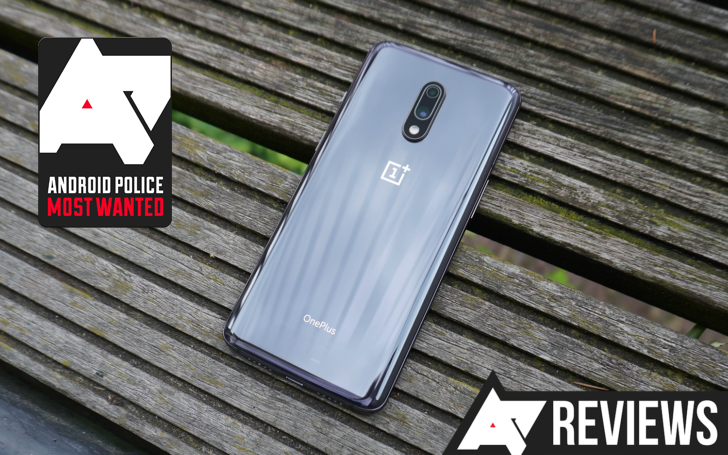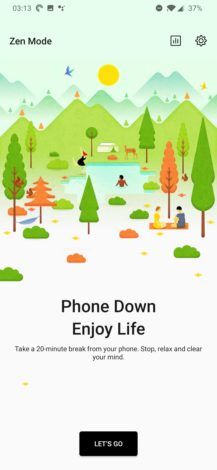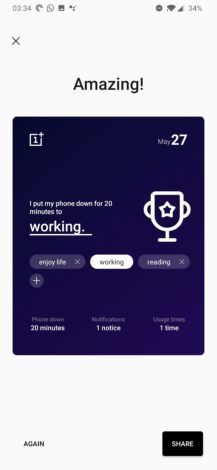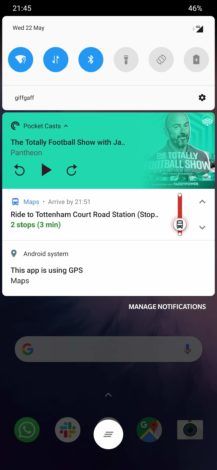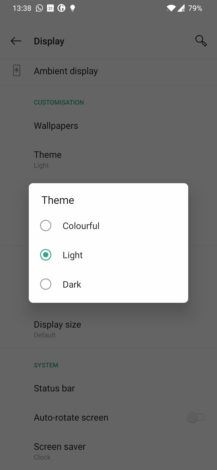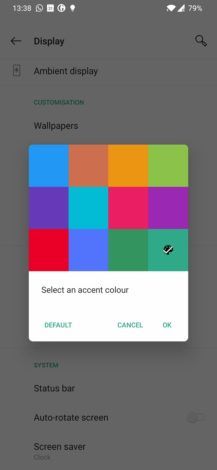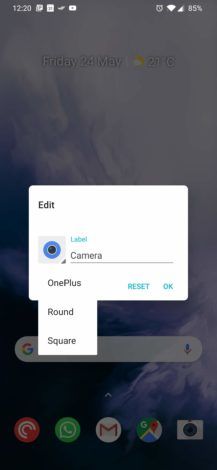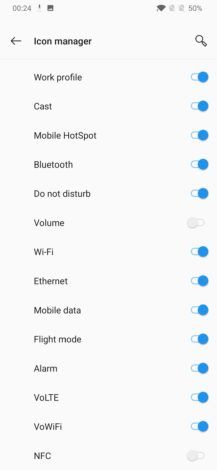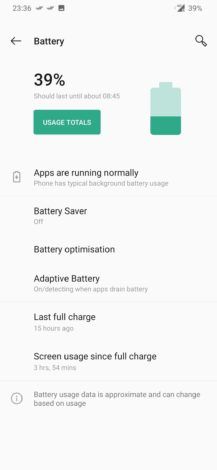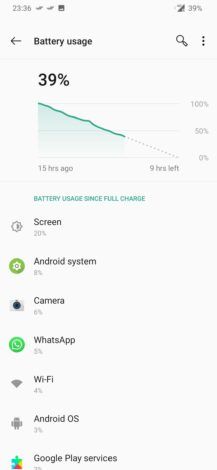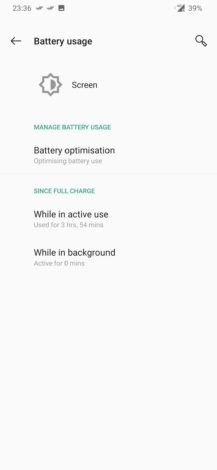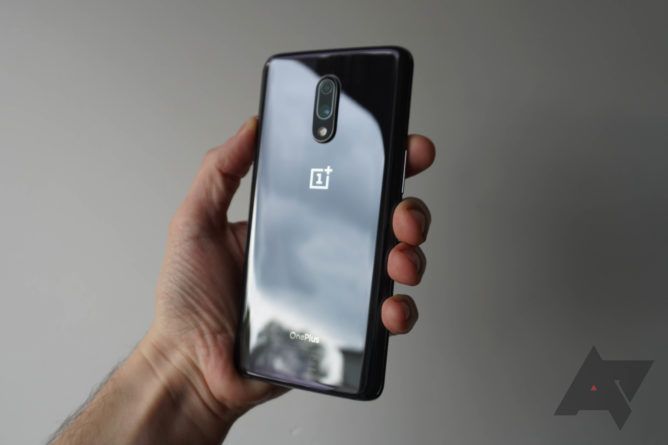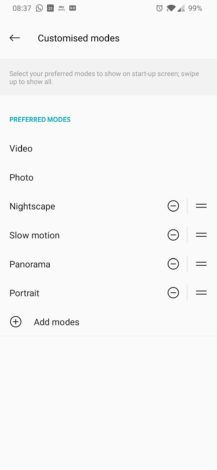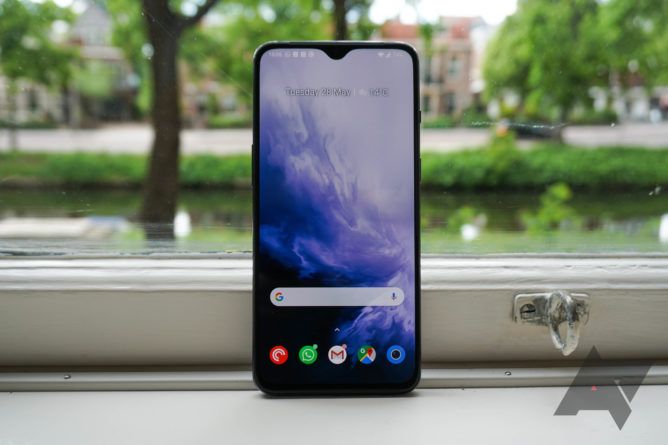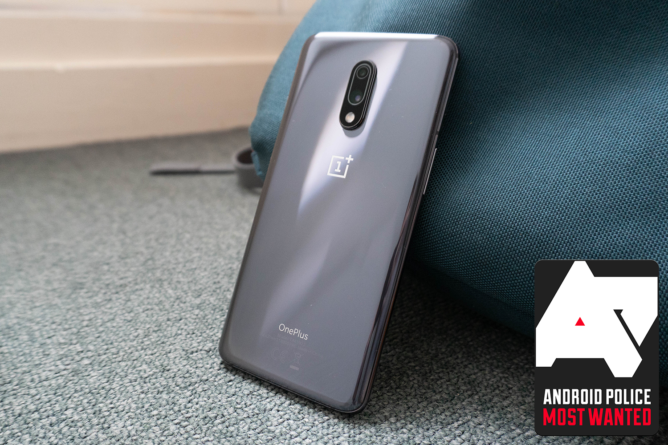In a long-expected move, OnePlus launched a more premium device earlier this month with a more premium price tag to boot. US consumers were presented the OnePlus 7 Pro as the only option for a brand-new OnePlus phone, but other markets have also been treated a with a cheaper alternative. The standard OnePlus 7 is something of an updated 6T — practically identical on the outside but with some significant enhancements on the inside — and at £499/€559, it also starts at the same price. Interestingly, the OnePlus 7 is even cheaper than the 6T in India where it starts at just 32,999 INR.
The Pro model has received glowing praise from reviewers everywhere and remains tremendous value at $670 (£649/€709). In our review, Ryne saw fit to label it the “best smartphone you can buy right now,” owing to its magnificent display, speedy performance, and solid cameras. The regular OnePlus 7 includes many of the same improved specs and features — Snapdragon 855, 48MP main camera sensor, UFS 3.0 storage, Dolby Atmos stereo speakers — and as such offers consumers in Europe and Asia the affordable flagship-killing package we’ve all come to expect from OnePlus.
SPECS
|
SoC |
Qualcomm Snapdragon 855 with Adreno 640 GPU |
|
RAM |
6 or 8GB |
|
Storage |
128 or 256GB (UFS 3.0) |
|
Display |
6.41-inch AMOLED, 19.5:9, 1080p |
|
Rear camera 1 |
48MP sensor (Sony IMX586), f/1.7 with OIS, EIS, PDAF, 4K video recording at 60fps |
|
Rear camera 2 |
5MP depth sensor |
|
Front camera |
16MP with EIS, 1080p video at 30fps |
|
Battery |
3,700mAh with 20W fast charging |
|
Software |
Oxygen OS (Android 9 Pie) |
|
Headphone jack |
404 not found |
|
Connectivity |
2.4/5GHz 2x2 MIMO Wi-Fi (up to ac), Bluetooth 5.0 (w/ aptX, aptX HD, LDAC, and AAC), NFC |
|
Other |
In-display fingerprint sensor, alert slider, dual stereo speakers, Dual nano-SIM slot, USB 3.1 |
|
Dimensions |
157.7 x 74.8 x 8.2mm |
|
Weight |
182g |
|
Colors |
Mirror Gray, Red (Asia only) |
|
Price |
6/128 — £499/€559 |
THE GOOD
|
Performance |
It’s buttery smooth and incredibly speedy, just as advertised. |
|
Design and build |
The waterdrop cutout is still relatively inconspicuous and the fit and finish throughout are top notch. Unlike the gigantic OnePlus 7 Pro, it fits nicely in the hand. |
|
Display |
1080p is absolutely fine on a screen of this size and the Samsung-made AMOLED panel used by OnePlus is a very good one. |
|
Software |
Oxygen OS is practically stock Android but with some really useful additions. Arguably better than what you get on a Pixel. |
|
Cameras |
Imaging performance isn’t quite top tier (think Pixel, P30 Pro, Galaxy S10) but it’s as close as OnePlus has ever come. |
|
Battery life |
Will get you through the day no problem. |
|
Audio |
Dual stereo speakers with Dolby Atmos-tuning are much improved over the single one on the 6T. |
|
Price |
Probably still the best value smartphone around, all things considered. |
THE NOT SO GOOD
|
Cameras, again |
Processing is still not on par with the best in the business, and with only two rear cameras, you don’t get the same versatility as the 7 Pro or even competitors in a similar price bracket like the Xiaomi Mi 9 and Honor 20 Pro. |
|
Design, again |
A glass back without wireless charging is just teasing, really. If I were to be really finicky, I’d say that the waterdrop notch solution isn’t quite as pretty as the punch-hole, and then there are already phones (like the 7 Pro) with no cutouts at all that make this thing look dated. That’s kind of clutching at straws though. |
|
No waterproofing |
It’s the same old story — OnePlus doesn’t do IP ratings. |
|
Headphone jack |
There isn’t one. |
Design, hardware, what’s in the box
If you’re familiar with the design of the OnePlus 6T, there won’t be too many surprises for you here. Differences include the earpiece, which is elongated and covers most of the width of the phone now, as it acts as one half of a Dolby Atmos stereo speaker pair, with the other residing on the bottom edge by the USB-C port. Only the left of the two bottom speaker grills emits sound while the other is just a dummy there for the sake of symmetry. The other noticeable difference is on the back where the dual-LED flash is now within the camera bump rather than separate — which looks cleaner even if there’s no functional reason for the change.
Outside those differences, we’re looking at the same 6.41-inch AMOLED display with an aluminum frame and glass rear panel, and the build quality is of the highest standard. The display panel itself is still lovely, although some might wish it could get brighter. It’s only 1080p, but that’s sharp enough for a screen of this size. One complaint I do have is that the auto-brightness can be aggressive at night, making the screen far too dim to be usable. I’m not sure if that’s due to a software issue that will be fixed or a problem with ambient light sensor — either way, it’s only a mild annoyance, easily rectified by manually pumping up the brightness until it learns your preferences.
Left: Next to its big sibling, the OnePlus 7 Pro. Right: The glorious sandstone case I've been using.
I’m still not convinced by in-display fingerprint sensors, but the one on the OnePlus 6T was better than most other implementations, and the one on the 7 is even better. As with the 7 Pro, the sensor area is larger which makes for faster and more consistent reads. Part of why in-display solutions still irk me is that the screen needs to get bright for it to work, and if you’re using night mode, this will be overridden on the lockscreen while your fingerprint is authenticated. This means that when waking your phone at night to check notifications, you’re greeted by bright, unfiltered light until you unlock or pull the notification shade down. And since you’ll likely have a few notifications with bright backgrounds waiting for you, this can be really blinding.
Subjective though it is, I think the OnePlus 7 looks good from the back, but I’m sad that Mirror Gray is the only color option. The Midnight Black 6T with its matte finish was far more attractive, but OnePlus has done away with it. There is a red version of this latest phone, but it’s only available in China and India for now. To the dismay of many, OnePlus removed the headphone jack with the last generation, and it’s missing once again. And while the 7 Pro got an updated vibration motor, the regular 7 still has mediocre haptic feedback. One hardware feature that continues to spark joy among OnePlus fans is the alert slider.
In the box, you’ll find a 20W power adapter with a USB Type-A to Type C cable. It won’t top up as fast as the 30W Warp charger that comes with the 7 Pro, but it’s still pretty rapid. The phone has a pre-applied screen protector, which is a nice touch, although I removed it as its sharp, raised edge made the swipe-up-for-home gesture feel unsatisfying. A TPU case is another pleasing inclusion, and while it’s perfectly adequate, it can’t beat the sandstone number OnePlus also sent me. It looks and feels great while also not covering the bottom of the screen, allowing swipe gestures to go unhindered. Cases are something the company really does excel at.
Performance, software, battery life
If there’s one area in which OnePlus would never cut corners, it’s performance. Advertisements from the company often focus on how fast and smooth the experience is, and the OnePlus 7 this in the same vein as its bigger sibling. The model I’ve been using has 8GB of RAM and 256GB of storage, alongside the Qualcomm Snapdragon 855 processor, but the 6/128GB variant should perform with similar excellence — those specs are more than enough in 2019. RAM Boost is a questionable feature, but I can’t deny opening and closing apps is a breeze, as is multitasking.
If you ever yearn for the days when we didn’t have phones at all, Zen Mode renders the OnePlus 7 Pro almost entirely useless for 20 minutes at a time (allowing only emergency calls and emergency camera use). Digital wellbeing is very in at the moment, and it’s not surprising that phone makers want to make you think they want to help with your phone addiction when really they just want to make you buy more phones. If you use your phone continuously for two hours, Zen Mode will also remind you to take a break. A native screen recorder is another new feature to arrive with the OnePlus 7 series. Both are accessible via quick settings toggles.
Oxygen OS is arguably the most polished Android skin, largely because it doesn’t mess too much with the core look and feel of the OS and offers some thoughtful additions rather than a bunch of bloatware. Theming is done well, although dark mode can’t be set to a schedule and doesn’t have a quick settings tile—that will come with Android Q, presumably. There are some other neat customization options, such as the ability to change launcher icons for individual apps. On phones other than a Pixel I always end up switching to a third-party app like Action Launcher, but that's not necessary on a OnePlus phone. Other delightful little touches are to be found in the software, including a cute take-off/landing animation when you toggle the airplane mode quick setting.
OnePlus' gestures are fairly usable — swipe up for home is pretty standard nowadays, as is holding for the app switcher. Where this system differs from that which Google will be launching with Android Q that the back button is a swipe up from the left or right bottom edge, rather than the sides. This eliminates conflicts with pull out side menus while being slightly less convenient, but I got used to it nonetheless. Pull up and to the right to quickly switch between apps is inconsistent and needs to be improved. If you use gestures, you lose easy access to the Google Assistant, but that's where one of Oxygen OS' best little features comes in — you can set the power button to trigger it with a 0.5-second long press (and hold for longer to get the power menu. The solution works so well I'm surprised Google hadn't thought of it already.
As much as I love the Oxygen OS experience, I do have some gripes worth pointing out. The clear all notifications button is far too prominent, and in roughly the same position as the fingerprint sensor, so this can lead to accidental batch dismissal when you’re on the lock screen and decide to unlock. I’m not sold on the shelf to the left of the home screen either, as I’m now so used to having Google’s Discover feed there. My biggest bugbear, however, is the lack of an always-on display feature. There is an ambient display option, but it only triggers when the phone is lifted or when you tap the screen. Since it used an AMOLED panel, there’s no good reason not to include AOD as an option, and it’s one of the main reasons I tend to go back to a Pixel after reviewing other devices.
The 3,700mAh battery has proven more than adequate in my time using the device, usually finishing each day with about 20-40% remaining with typical screen-on time of around 4 hours. So it's been mostly pretty decent but not as impressive as other phones I've recently used, such as the Honor 20 Pro. As usual, your mileage will vary.
Camera
OnePlus lagged behind the competition in the camera department for years but made great strides with the 6 and 6T. While the cameras on the OnePlus 7 Pro continue to close the gap, even that flagship model still doesn’t quite match the Google Pixel, Huawei P30 Pro, and Samsung Galaxy S10+ when it comes to imaging. It’s a similar story for the regular OnePlus 7, which uses the same 48MP main rear camera sensor and 16MP front selfie cam. It lacks the 7 Pro's wide angle and telephoto lenses, however.
Pixel binning on the 48MP sensor means it outputs 12MP images by default — you have to use the pro camera mode to make use of the full available resolution. Even so, you get far more detailed shots than previous OnePlus phones were able to achieve, and they compare favorably to those taken with other high-end smartphone cameras. Exposure and color accuracy still need improvement, and HDR only kicks in for certain scenes and can still be a little inconsistent. All that said, OnePlus is going in the right direction and camera performance is no longer a significant reason not to buy a OnePlus phone, in my opinion.
It's great that you can choose which shooting modes appear in the camera app's carousel.
Low light photography is a clear focus for most phone manufacturers at the moment and, to that end, Nightscape 2.0 debuts on the OnePlus 7 and 7 Pro. Even in the normal camera mode, the main sensor is capable of pulling in an impressive amount of light, and while Nightscape improves the dynamic range a little, it’s not as effective or eye-catching as on other competing phones. The night modes on the Pixel, P30 Pro, and even the Honor 20 Pro all produce incredible results that beat the OnePlus hands down.
Portrait mode on the OnePlus 7 seems more concerned with artificial smoothing of people’s faces than any noticeable depth effect, so you have to wonder if the secondary depth-sensing camera could have been replaced by a more interesting telephoto or wide angle option. It can do 4K video recording at 60fps, although the super slow motion can only manage 480fps at 720p or 240fps at 1080p.
Should you buy it?
Definitely. What’s telling is how much I struggled coming up with negative things to write about the OnePlus 7. And that’s not to say it’s absolutely perfect, but as a whole package, it’s very polished. Performance is great, animations are smooth, the speakers are much better than before, and the software up there with Google’s Pixel version of Android, if not better. Camera quality would have been a real downside for OnePlus in years gone by, but it’s more than good enough these days. For just £499/€559 you’re getting a phone that does most things excellently, just like its predecessor, and that was our smartphone of the year for 2018.
There are trade-offs like no wireless charging and no official IP rating, but most people can probably live with that. You can spend more and get a slightly better phone, but you’ll be hard pressed to find anything better for the same money. If photography is more important to you, the Xiaomi Mi 9 or Honor 20 Pro might be better choices, but the OnePlus 7 is undoubtedly nicer to use — it's the one I'd choose every time.
Buy if:
- You want the best value smartphone available, with incredible performance and lovely software
Don’t buy if:
- You want the best possible photography experience.
Where to buy
The OnePlus 7 will be available to buy from June 4.

